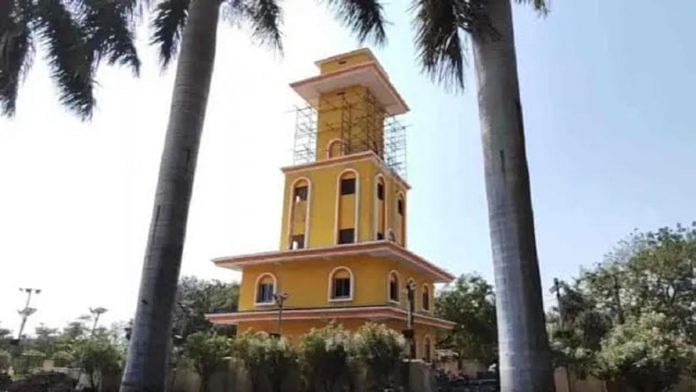Bhopal: The Madhya Pradesh government is all set to unveil the world’s first vedic clock — which will introduce an alternate time format based on India’s ancient timekeeping system as mentioned in Rigveda — at Ujjain’s Jantar Mantar on 1 March.
The clock will display the time in terms of mahurats, kaals, and kasthas, which are units of time in the vedic system corresponding to hours, minutes, and seconds, respectively. It will also show the Greenwich Mean Time (GMT) and the Indian Standard Time (IST) for comparison.
The vedic time format will be presented in a digital format on an LED screen, which will be put up at an 85-ft high tower constructed at Jantar Mantar. The tower is located inside the campus of the 300-year-old Jiwaji Observatory in Ujjain.
According to Sri Ram Tiwari, director of state-owned Ujjain-based Maharaja Vikramaditya Research Institute, it was Chief Minister Mohan Yadav who supported Lucknow-based software engineer Aaroh Shrivastav to develop the clock way back in 2017.
“The clock, which cost Rs 5 lakh, is all set to be inaugurated by the CM on 1 March on the first day of Vikram Utsav, which will be held between 1 March and 9 April,” said Tiwari.
During his first speech in the state assembly in December, Yadav stated that his government would prove that “Ujjain is the global Prime Meridian and correct the time of the world”.
In 2020, Tiwari said, Yadav, the then higher education minister, donated Rs 1.58 crore from his MLA fund for the construction of the tower. “While Ujjain is the beginning, in the near future similar clocks are likely to be displayed at different parts of the state.”

Also Read: Amid switchover buzz, Kamal Nath’s son says will walk with Rahul when yatra passes through MP
How vedic clock works
Explaining how the time will be calculated, Shrivastav told ThePrint that the vedic time format displayed on the LED screen will be calculated between one sunrise to another. The period between two sunrises is divided into 30 equal parts called mahurats (hours), each of which has 30 kaals (minutes) and each kaal has 30 kasthas (seconds), he added.
Shrivastav, who has been working with the MP government since 2017 to execute the project, said that it was in 2016 while working in the merchant navy, that he developed a fascination with the concept of time.
He said that during his subsequent visit to Greenwich, he learnt that Prime Meridian at Greenwich — considered a reference line for Greenwich Mean Time (GMT) — was accepted internationally based on imperial influence.
“The concept of 24 hours finds its origin in Egyptian culture. It was between 14 and 16 centuries that France made the first clock based on this Egyptian concept of time, and subsequently, it was popularised by England, which owned the East India Company — controlling 70 percent of ships in the world used for trading,” said Shrivastav.
According to him, the first civilisation to have the concept of time was in India, where about 5,000 years ago, people understood time and classified it as muhurat, kaal and kastha.
“I then decided to come up with a clock based on our culture and its understanding of time,” Shrivastav highlighted.
He added that, according to the Hindu astronomical belief, Ujjain naturally marks a point on the Earth where the Tropic of Cancer interacts with the celestial equator — making it a zero meridian point.
From about the 4th century B.C., Ujjain enjoyed the reputation of being India’s Greenwich. Dongla observatory in Ujjain is constructed precisely on the point where this intersection occurs, much like the Greenwich observatory that determines the Prime Meridian, said Shrivastav.
In 2020, Shrivastav embarked on a cycling tour from Lucknow to Kanyakumari to spread awareness about the project and met influential people, including politicians affiliated with various cultural and social organisations.
“When I was crossing Madhya Pradesh, I came in contact with Usha Thakur, then minister for culture and tourism in the state cabinet, as well as Mohan Yadav, who appreciated the concept,” he added.
After several failed attempts to set up a mechanical clock that could measure the sunrise according to the vedic time, Shrivastav decided to come up with a digital clock that could display the concept. When the Vedic clock displayed ‘00’, it would be the precise point of sunrise, he said.
“One year marks a rotation of Earth around the sun. Basically it is a solar calendar, but then why is it that a day does not begin and end from one sunrise to another and does not function in the local meantime?” he questioned.
While the LED screen will display the vedic clock according to the sunrise in Ujjain, Shrivastav has also developed a vedic digital clock app, which will be active from 1 March, and can be downloaded on phones — allowing anyone residing in any part of the world to follow the vedic time period.
The app, which has been patented, will go live after the official inauguration, Shrivastav told ThePrint. It will also display planetary position, yog, auspicious and inauspicious periods, fasting days, festivals, sunrise, and sunset, among other things, he added.
(Edited by Richa Mishra)
Also Read: ‘Fashionable to demolish homes without following principles of natural justice’ — Madhya Pradesh HC







I noticed in the Clock”s display of muhurta that the equivalent words for AM and PM in Hindi (Sanskrit), which are “Poorvanha” and “Aparanha”, are wrongly spelt as “Poorvahna” and “Aparahna”.
The duration between sunrise to sunrise will vary from season to season, will it not? So, using the Vedic click, are we to understand that the smaller units also will have durations which are not fixed but will vary over the year? Confusion in plenty!!!